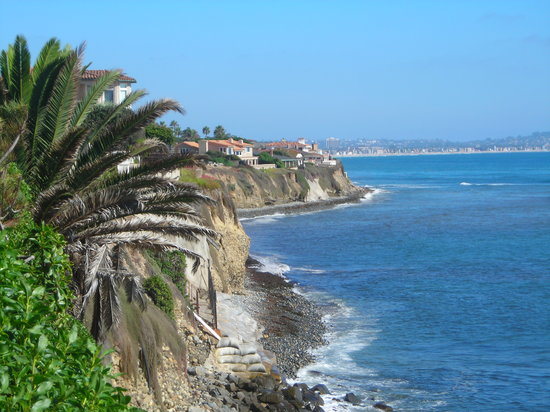San Diego, California is located in the Pacific Mountains and Valleys region of the United States. The Pacific Mountains and Valleys region runs from the California Pacific Coastline all the way up north to Washington. It is characterized by numerous mountain chains and abrupt changes in elevation. The Coast Range is an extensive area in California with peaks reaching 3,000 meters. This range is 840 miles long and it rises from the shore in steep cliffs ad terraces. This physiographic region is also famous for it's abundance of sandy beaches. There is also a major fault zone running along Southern California which is a source of frequent earthquake activity.
The San Diego Ranges, also know as the Peninsular Ranges, are comprised of the Aqua Tibia, Laguna, and Vallecito Mountains which extend southward into Baja California. San Diego encompasses 70 miles of coastline and is known for it's hilly geography. It is bordered on the west by the Pacific Ocean and has miles of lush, sandy beaches. Metropolitan San Diego is crossed by five west flowing rivers and several streams. These geographic features aid the creation of San Diego's canyons, gorges, and mesas. The city of San Diego rests upon steep canyons and hills which effectively separate it's mesas. The San Diego River, another distinguishing geographic feature of the the city, runs directly through the center of San Diego.
 |
| Overview of the Topography of San Diego |
| The San Diego River |
Climate: San Diego, California is known for it's idealistic weather conditions. The sun shines for the vast majority of the year and the weather is fairly consistent when compared to other regions in the United States. The climate is officially classified as Mediterranean which means that there is moderate precipitation in the mild winters and the summers are fairly warm. The weather in San Diego is mostly sunny and the presence of severely cold or scorching hot weather is highly unlikely. The average temperature in Fahrenheit in January is about 57.3 degrees and in August it is 72.5 (rssweather.com). There have been incidences of temperatures exceeding 90 degrees during the hottest summer months although these occurrences are rare. The precipitation rate is less than 12 inches per year which makes San Diego a borderline arid city. San Diego is prone to floods and droughts and is also plagued by the Santa Ana winds. Out of the 125 years of weather recording, there has only been five reported days of snow falling. Overall, San Diego's weather is perfect if you enjoy the laid back atmosphere of leisurely, sunny beach living. Here is a video of the typical weather forecast in San Diego during July:
Vegetation and Soils:
The southern region of California is classified as sclerophyllous vegetation area. According to enclyopedia.com, sclerophyllous vegetation is typically scrub, but also forest, in which the leaves of the trees and shrubs are evergreen, hard, thick, leathery, and usually small. These adaptations allow the plants to survive the pronounced hot, dry season of the Mediterranean-type climate in which sclerophyllous vegetation is best developed. Different types of vegetation that thrive in this area include: pine trees, oak trees, citrus trees, manzanita schrubs, sagebrush, and fig trees among numerous others. San Diego is classified under the highland soil category which is generally unproductive but mollisols and alfisols can also be found in this region, which are both very productive soils. Here are a few examples of the beautiful vegetation that grows on San Diego's home turf:
| Purple Ice Flower |
 |
| Southern Red Monkeyflower |

No comments:
Post a Comment